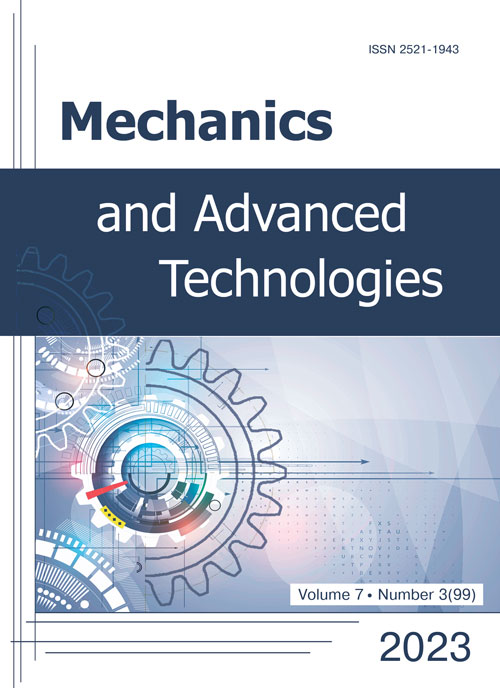Review of methods of degassing of working fluids
DOI:
https://doi.org/10.20535/2521-1943.2023.7.3.290444Keywords:
ultrasound, ultrasonic treatment, decontamination, ultrasonic cavitation, ultrasonic emitterAbstract
The article discusses known methods of degassing working fluids. A brief description of known degassing methods is given, an analysis of their advantages and disadvantages is provided. Emphasis is placed on the ultrasonic method of degassing, which is implemented with the help of low-amplitude and high-amplitude ultrasonic emitters. Illustrative photo materials of an experimental study of the ultrasonic method of degassing with the involvement of piezoelectric transducers are presented. The need for additional work to increase the efficiency of ultrasonic degassing by means of an experimental study of the influence of the frequency, amplitude and intensity of ultrasonic oscillations on the degassing process is formulated.
References
- L. Z. Alekseev and U. A. Gladkov, Improvement of soft water quality. Moscow: Stroyizdat, 1994, 150 p.
- O. A. Kapustina, “Degassing of liquids”, in Physical bases of ultrasonic technology. Moscow: Nauka, 1970, pp. 253–336.
- O. A. Kapustina, “On the dependence of the degree and efficiency of ultrasonic degassing of liquid on the radiated power”, Acoustic Journal, vol. 9, no. 4, pp. 424–426, 1963.
- Ja. Stryczek, P. Antoniak, M. Banas, P. Stryczek, O. Jakhno, O. Luhovskyi and I. Gryshko, “Physical fudamentals of ultrasonic degassing”, Bulletin of the National Technical University “KhPI”, no. 1, pp. 17–22, 2021.
- L. A. Crum and G. M. Hansen, “Growth of air bubbles in tissue by rectified diffusion”, Phys. Med. Biol., vol. 27, no. 3, pp. 413–417, 1982. DOI: https://doi.org/10.1088/0031-9155/27/3/008.

- O. A. Kapustina, “On the kinetics of ultrasonic degassing of liquid in the precavitation mode”, Acoustic Journal, vol. 10, no. 4, pp. 440–443, 1964.
- V. N. Khmelev, R. V. Barsukov, M. V. Khmelev and S. N. Tsyganok, “Increasing the efficiency of ultrasonic impact on liquid media”, Polzunov Bulletin, no. 3, pp. 172–179, 2007.
- M. Ashokkumar, J. Lee, S. Kentish and F. Grieser, “Bubbles in an acoustic fild: An overview”, Ultrasonics Sonochemistry, vol. 14, no. 4, pp. 470–475, 2007. DOI: https://doi.org/10.1016/j.ultsonch.2006.09.016.

- Ultrasound. Small Encyclopedia, I. P. Golyamina Eds. Moscow: Soviet Encyclopedia, 1979, 400 p.
- O. M. Yakhno, E. A. Lugovska and A. V. Movchanyuk, “Investigation of the possibilities of ultrasonic cavitation cleaning technology for elastic surfaces”, Journal of Mechanical Engineering NTUU “Kyiv Polytechnic Institute”, no. 58, pp. 234–240, 2010.
- O. Lugovskyi, A. Movchanyuk and V. Fesich, “To the question about the calculation of the ultrasonic step-up transformer of vibrating speed with the developed radiance surface”, Mech. Adv. Technol., no. 1 (85), pp. 49–56, Apr. 2019. DOI: https://doi.org/10.20535/2521-1943.2019.85.164346.
- O. Lugovskyi, A. Movchaniuk, I. Bernyk, A. Shulga and I. Hryshko, Hardware of ultrasonic cavitation technologies. Kyiv: "Igor Sikorsky Kyiv Polytechnic Institute", 2021, 216 p.
- A. F. Lugovskyi and N. V. Chukhraev, Ultrasonic cavitation in modern technologies. Kyiv: PPC “Kyiv University”, 2007, 244 p.
Downloads
Published
How to Cite
Issue
Section
License
Copyright (c) 2023 Олександр Луговський, Олексій Петренко

This work is licensed under a Creative Commons Attribution 4.0 International License.
Authors who publish with this journal agree to the following terms:
- Authors retain copyright and grant the journal right of first publication with the work simultaneously licensed under CC BY 4.0 that allows others to share the work with an acknowledgement of the work's authorship and initial publication in this journal.
- Authors are able to enter into separate, additional contractual arrangements for the non-exclusive distribution of the journal's published version of the work (e.g., post it to an institutional repository or publish it in a book), with an acknowledgement of its initial publication in this journal.
- Authors are permitted and encouraged to post their work online (e.g., in institutional repositories or on their website) prior to and during the submission process, as it can lead to productive exchanges, as well as earlier and greater citation of published work











